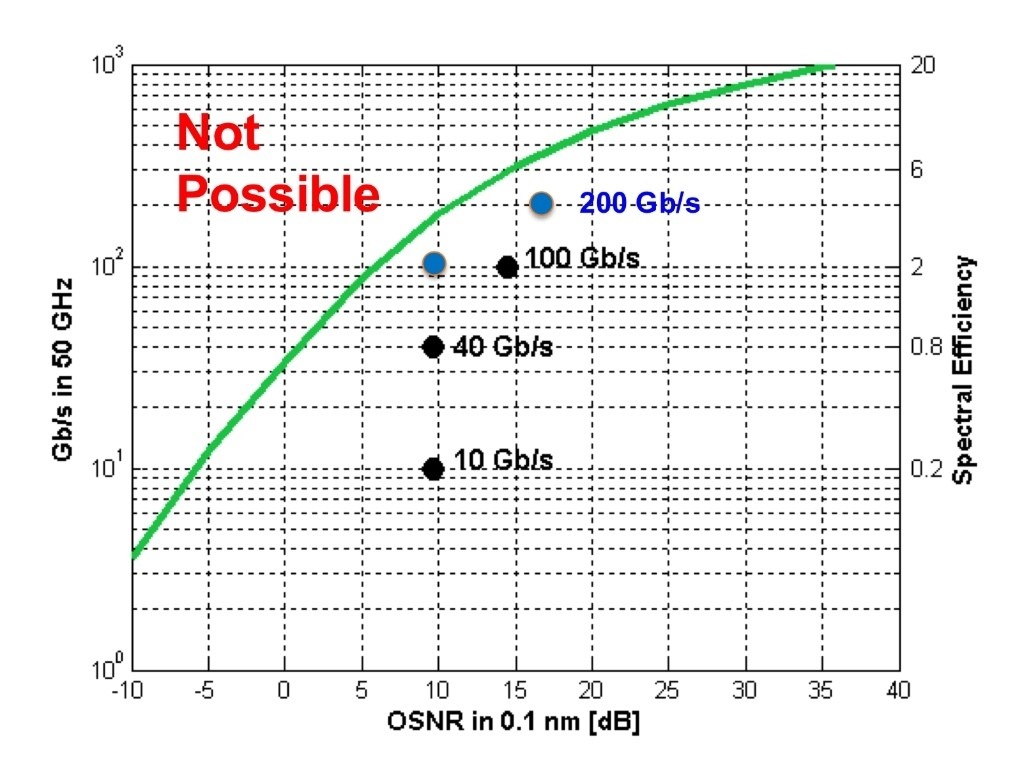The capacity limits facing optical networking
 Tuesday, May 15, 2012 at 8:45AM
Tuesday, May 15, 2012 at 8:45AM Ever wondered just how close systems vendors are in approaching the limits of fibre capacity in optical networks? Kim Roberts, senior director coherent systems at Ciena, adds some mathematical rigour with his explanation of Shannon's bound, from a workshop he gave at the recent Layer123's Terabit Optical and Data Networking conference held in Cannes.
Part 1 Shannon's bound
 Source: Ciena
Source: Ciena
One positive message from Kim Roberts is that optical networking engineers are doing very well at squeezing information down a fibre. But a consequence of their success is that the scope for sending yet more information is diminishing.
"The key message is we are reaching that boundary," says Roberts. "We are not going to have factors of 10 improvement in spectral efficiency."
Shannon's bound
The boundary in question - the green line in the chart above - is based on the work of famed mathematician and information theorist, Claude Shannon. The chart shows how the amount of information that can be sent across a fibre is ultimately dictated by the optical signal-to-noise ratio (OSNR).
To understand the chart, the axes need to be explained. The y-axis represents the Gigabits-per-second (Gbps) of information to be communicated error free in a 50GHz ITU-defined channel. The second, right hand y-axis is an alternative representation, based on spectral efficiency: How many bits/s are transmitted, error free, per Hertz of optical spectrum. For example, 100Gbps fitted within a 50GHz channel (see 100Gbps black dot) has 2bits/s/Hz spectral efficiency.
The horizontal axis is the OSNR, measured as the total power in the signal divided by the noise in a tenth of a nanometer of spectrum.
The curve, in green, shows where communication is possible and where it is not, based on Shannon's bound. "Shannon described that for a given bandwidth - 50GHz in this example - based on the amount of noise present, specifically the signal-to-noise ratio - is the limit of the amount of information that can be communicated error free."
Roberts points out that Shannon's work was based on a linear communication channel with added Gaussian noise. Fibre is a more complex channel but the same Shannon bound applies, although some assumptions must be made. "There are certain assumptions for the non-linearities in the fibre," says Roberts. "If you make reasonable assumptions, you can draw this [Shannon] bound which shows where it is possible - and where it is not - to operate."
The dots on the chart represent the different generations of Ciena's optical transmission systems based on its WaveLogic coherent ASIC technology. The 10Gbps black dot is the performance of Ciena's first generation WaveLogic silicon. The black dot at 40Gbps and 100Gbps represent the performance achieved using Ciena's WaveLogic 2 40 and 100Gbps ASICs, shipping since 2009.
The two blue dots - at 100Gbps and 200Gbps - represent the performance achieved using Ciena's latest WaveLogic 3 silicon shipping this year. The 100Gbps is achieved using dual-polarisation, quadrature phase-shift keying (DP-QPSK) and the 200Gbps using DP-16QAM (quadrature amplitude modulation). The 200Gbps data after forward error correction in a 50GHz channel achieves 4bits/s per Hertz of spectrum.
The 100Gbps WaveLogic 3 (blue dot) delivers improved performance compared to the 100Gbps WaveLogic 2 (black dot) silicon by shifting the performance to the left, closer to the bound.
"Moving to the left means tolerating more noise, which can be translated to longer reach or higher-noise bands or more tolerance for imperfections in the network." Just how this improved performance - in terms of gained decibels (dBs) - is used depends on whether the network deployment is a long-haul or metro one, says Roberts.
What next?
Moving to faster data rates - vertically on the graph - raises its own issues. A Terabit - 1,000Gbit/s - in a 50GHz channel requires an OSNR in excess of 35dB. "That is not something that can be achieved in the network," says Roberts. "For a robust network you want to tolerate 20dB, or at least be left of 25dB." As a result, a practicable 1Tbps signal is not going to fit in a 50GHz channel.
The chart does imply that 400Gbps might be practicable in a 50GHz channel but as Roberts points out, while it might be theoretically possible, the closer you get to the theoretical limit, the harder it is to achieve.
"To increase capacity we need to find ways of reducing the noise on the line to move more to the right [on the chart]," says Roberts. "We [optical networking engineers] also need to push the data points to the left and vertically, but we are not going to push beyond the green."
Further Reading:
Capacity Trends and Limits of Optical Communication Networks, Proceedings of the IEEE, May 2012.
Part 2: Optical transmission's era of rapid capacity growth
Part 3: 2020 vision



Reader Comments